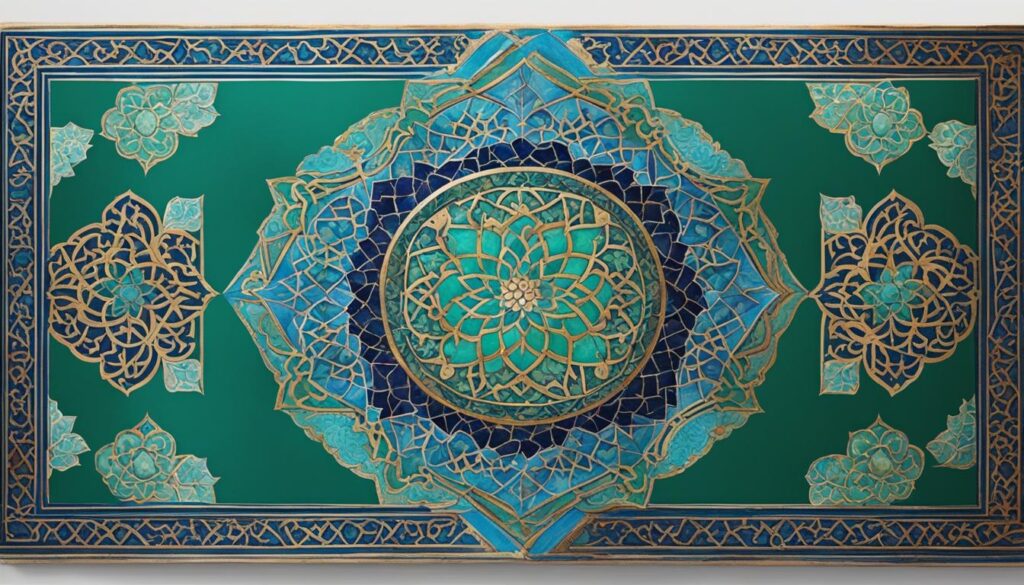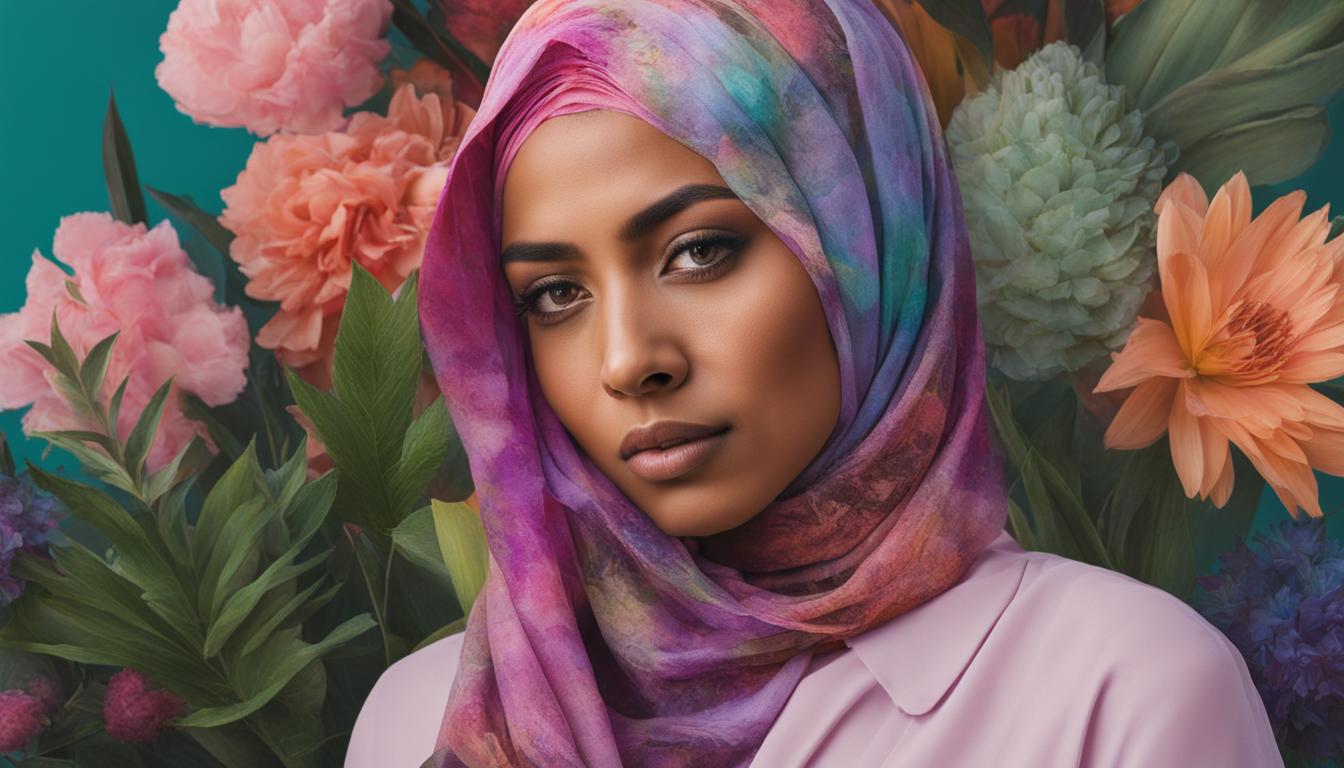When it comes to hair dyeing, Muslim individuals often have questions about what colors they are allowed to use while adhering to Islamic guidelines. In this section, we will provide insights and tips regarding the permissible hair dye options for Muslims, including halal hair dye, henna hair dye, natural hair dye, and more.
Key Takeaways
- Islamic guidelines prohibit certain shades produced by safflower and saffron, but yellow and red shades are generally allowed.
- The use of artificial color contact lenses is considered a form of artificial beautification and is generally prohibited.
- Hair dyeing using substances other than henna is allowed, and chemical-free options are not explicitly prohibited.
- It is important to ensure that any hair dye used is sharia compliant and follows the guidelines set forth by Islamic principles.
- Consulting with a trusted religious authority or scholar can provide further guidance on specific hair dye colors for Muslims.
The Symbolism of Color in Islamic Art
The use of color in Islamic art holds deep symbolism and significance, offering insights into cultural and religious values. From the vibrant hues adorning Persian mosques to the intricate color palettes in Indian architecture, the choice of colors in Islamic art reflects a rich tapestry of meaning and visual storytelling.
In Persian mosques, blue is often used to represent spirituality and the divine. It symbolizes the sacred sky and is believed to connect earthly realms with the heavens above. Pearl white, on the other hand, signifies purity and transcendence. It is associated with light, holiness, and the divine qualities of God. Meanwhile, sandstone red is a color that represents power, strength, and majesty. It exudes a sense of grandeur and authority, making it a prominent choice in Islamic architectural designs.
While these colors are commonly observed in Islamic art, the symbolism of color in this context is still an area that requires further exploration. Understanding the symbolic meanings associated with different colors in Islamic art is crucial for appreciating the depths of visual expression and cultural significance embedded within these artistic traditions.
Color in Persian Mosques and Indian Architecture
The use of color in Persian mosques and Indian architecture not only enhances the aesthetic appeal but also serves as a visual language to communicate profound spiritual and cultural symbolism. By exploring the color palettes employed in these architectural wonders, we can gain insights into the religious beliefs, cultural values, and historical contexts that shape Islamic art. Delving deeper into the symbolism of color in Islamic art will allow us to appreciate the beauty and significance of these artistic traditions in a more nuanced way.
Color Terminology in the Bible
When examining the language and symbolism of color in the Bible, one delves into a rich tapestry of meaning and significance. Although the subject has been overlooked in many studies, color plays a significant role in biblical text, offering insight into cultural and artistic expressions.
The use of color in the Bible is not solely descriptive; it often carries symbolic connotations. Various color terms are found throughout the text, conveying deeper meanings beyond their visual representation. By understanding the language of color in the Bible, we can uncover the layers of symbolism embedded within.
The Language of Color in Biblical Text
The color terminology in the Bible reflects the cultural context of ancient civilizations. Certain colors hold specific meanings and associations, giving additional depth to the narrative. For example, the color purple is often associated with royalty, while white symbolizes purity and innocence.
The study aims to explore the color terms used in the Bible and their significance, both within the biblical text and in relation to broader cultural and artistic expressions. By analyzing these color terms, we can gain a deeper understanding of the symbolism and metaphorical language employed in biblical narratives.

Overall, the exploration of color symbolism in Islamic book painting provides valuable insights into the cultural and artistic significance of this unique art form. The careful use of colors to convey specific meanings and evoke emotions adds depth and richness to the visual narratives depicted in these works. By delving into the symbolism associated with different colors, we can enhance our understanding and appreciation of Islamic art and its enduring impact on artistic traditions around the world.
The Linguistic Study of Color Terms in the Bible
The language of color in the Bible is a fascinating area of study that allows us to gain insight into the symbolism and meaning behind color in ancient civilizations. By examining the various versions of the Bible, including Hebrew, Greek, and Latin, researchers can uncover the richness and depth of color terms used in biblical texts. This linguistic study delves into the language of color in the Bible, exploring the significance of color terms and their representation.
Color terms in the Bible hold both literal and symbolic meanings, offering a glimpse into the cultural and historical context of ancient societies. Through the lens of cognitive linguistics, researchers analyze the cognitive domains, metaphorical associations, and metonymic extensions of color terms to better understand their usage and symbolism. This study seeks to unravel the nuances and complexities of color terms in the Bible, shedding light on their significance and cultural implications.
The Language of Color and its Symbolism
The language of color in the Bible serves as a powerful tool for conveying meaning and symbolism. Colors such as white, red, blue, and green are replete with significance, representing purity, sacrifice, divinity, and fertility, respectively. By examining the usage of color terms in different biblical contexts, researchers can uncover the intricate web of symbolism woven throughout the text.
Furthermore, this linguistic study explores the polysemic nature of color terms in the Bible. It investigates how a single color term can encompass multiple meanings, depending on the context in which it is used. Through an in-depth analysis of these polysemic color terms, researchers can gain deeper insights into the layers of symbolism embedded within the biblical text.
Overall, the linguistic study of color terms in the Bible offers a deeper understanding of the language of color and its symbolic significance within ancient civilizations. By exploring the cognitive, metaphorical, and cultural dimensions of color terms, researchers can unravel the rich tapestry of meaning and symbolism that colors hold in biblical texts.
The Symbolism of Color Terms in Islamic Literature
Color terms in Islamic literature hold deep symbolic meanings that have played a significant role in shaping cultural and artistic expressions. Through an examination of various works such as the Khamsam of Nizami and the accounts of Khosraw and Shirin, Nazm and Aminah, and Yaghma-Naz and Yaghma, the symbolism associated with specific colors comes to light. These color terms go beyond their literal descriptions and carry deeper cultural and artistic significance within the Islamic literary tradition.
In Islamic literature, color terms are used to evoke emotions, convey themes, and enhance storytelling. Each color holds a specific symbolic value that contributes to the overall meaning of the narrative. For example, the color green is often associated with fertility, prosperity, and the natural world. It can symbolize youth, growth, and rebirth.
Furthermore, the symbolism of color terms in Islamic literature extends beyond individual works and has influenced broader cultural and artistic expressions. Understanding the symbolic significance of color terms allows readers to delve deeper into the richness and complexity of Islamic literary traditions, gaining insights into the cultural values, beliefs, and aesthetics of the time.
The Importance of Color Symbolism
The symbolism of color terms in Islamic literature serves as a powerful tool for storytelling and communication. It adds depth and layers of meaning to the text, allowing readers to engage with the narrative on a more profound level. Through the use of color symbolism, writers and poets create vivid imagery and evoke emotions that resonate with readers.
Moreover, the symbolism of color terms in Islamic literature reflects the broader cultural and religious contexts in which these works were created. Islamic literature encompasses a wide range of genres and themes, from epic poetry to mystical writings, and each utilizes color symbolism in its unique way. By exploring the symbolism of color terms in Islamic literature, we gain a deeper understanding of the cultural nuances, spiritual traditions, and artistic sensibilities that shaped these literary masterpieces.
Overall, the symbolism of color terms in Islamic literature is a subject of great significance and deserves further exploration. By analyzing the color symbolism in specific works and tracing its influence on broader cultural expressions, we can gain valuable insights into the multifaceted nature of Islamic literature and the cultural heritage it represents.
Conclusion
In summary, the exploration of what colors Muslim individuals can dye their hair has provided insights into the guidelines set by Islamic teachings. While some shades produced by safflower and saffron are prohibited, yellow and red shades are not explicitly forbidden. Contact lenses that artificially change eye color are generally prohibited as they are considered a form of artificial beautification. However, hair dyeing with substances other than henna is allowed, and chemical hair dyes are not explicitly banned.
Further research is needed to gain a comprehensive understanding of color symbolism in Islamic art, the Bible, Islamic book painting, and Islamic literature. Studying the cultural and artistic significance of color in these contexts will provide a deeper understanding of their impact on visual culture and artistic expressions in European society.
By examining color terms in Islamic literature and specific works such as the Khamsam of Nizami, insights into the symbolism associated with different colors can be uncovered. This exploration of color terms will shed light on the cultural and artistic significance of color in Islamic literature.
Overall, understanding the guidelines and symbolism regarding color in Islamic contexts is crucial for appreciating the rich cultural heritage and artistic expressions associated with color in Muslim communities. Further research will contribute to a more comprehensive understanding of these important aspects.
FAQ
What colors are Muslim men allowed to dye their hair?
Muslim men are allowed to dye their hair with substances other than henna. Chemical hair dyes are not explicitly prohibited, as long as they are not permanent or black.
Are color contact lenses allowed for Muslim individuals?
No, the use of color contact lenses is generally prohibited in Islam, as it is considered a form of artificial beautification.
What are the guidelines for dyeing clothing in Islam?
According to Islamic guidelines, dyeing clothing with safflower or saffron is prohibited for Muslim men due to their similarity in shades. The specific shades of orange, deep orange, and brown produced by safflower are the ones specifically prohibited.
Are there specific colors designated for Muslim men to wear?
No, men are not designated specific colors to wear. They can wear a variety of colors as long as they are not clearly prohibited.
Can Muslim individuals dye their hair with black hair dye?
Muslim individuals are encouraged to avoid using black hair dye, as seen in the case of a man being asked to change the color of his white hair using a dye other than black. However, chemical hair dye is not explicitly mentioned as prohibited, as long as it is not permanent or black.

